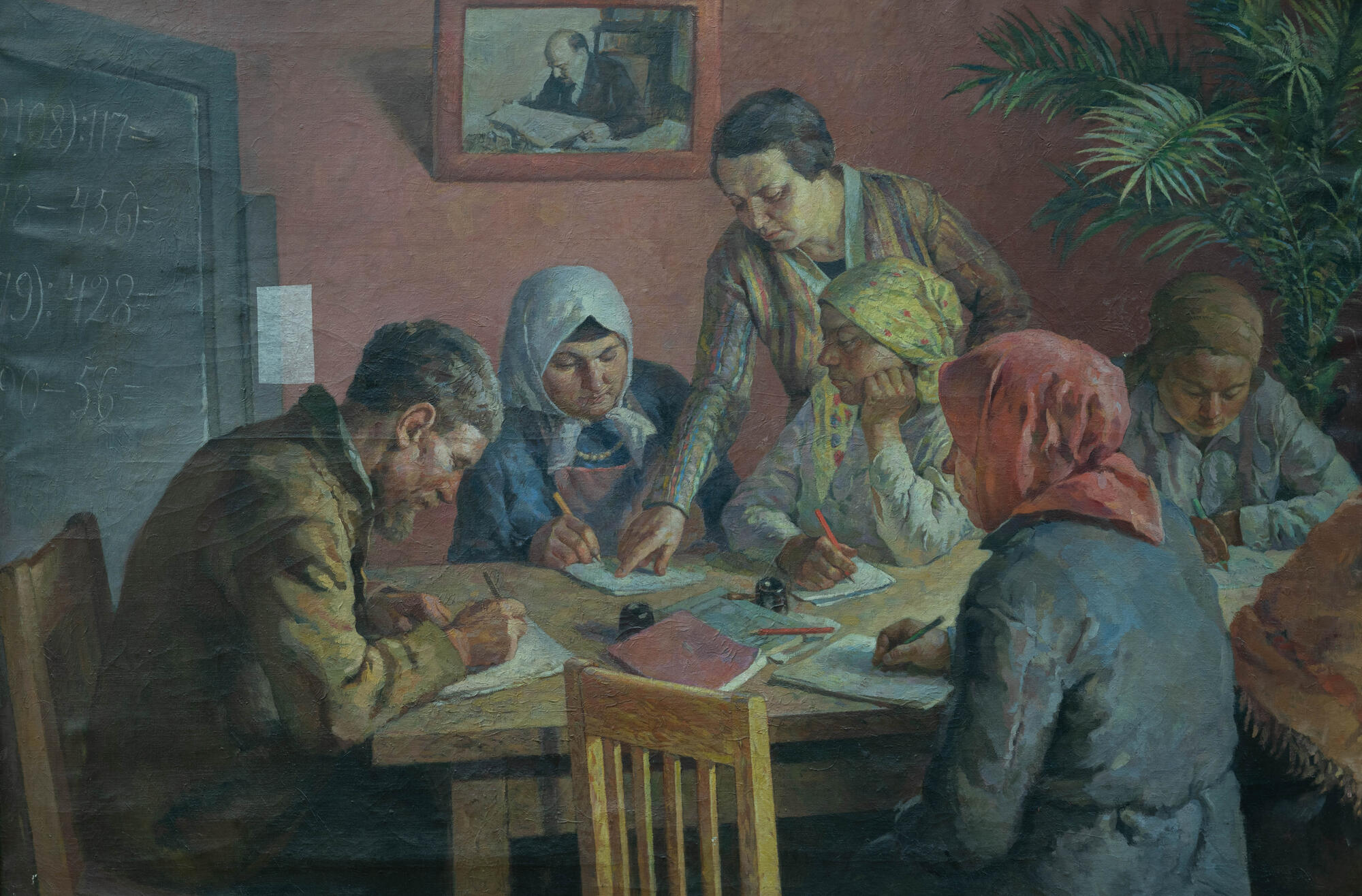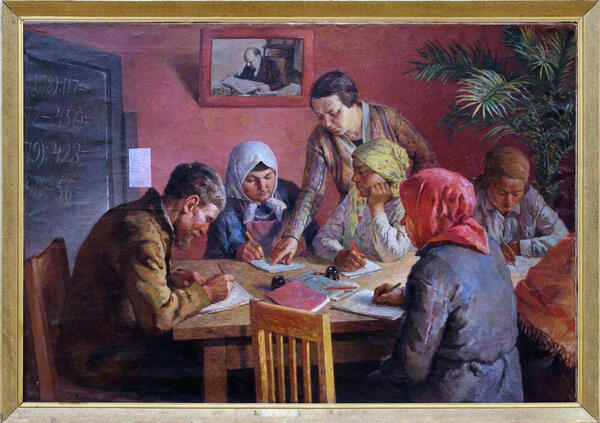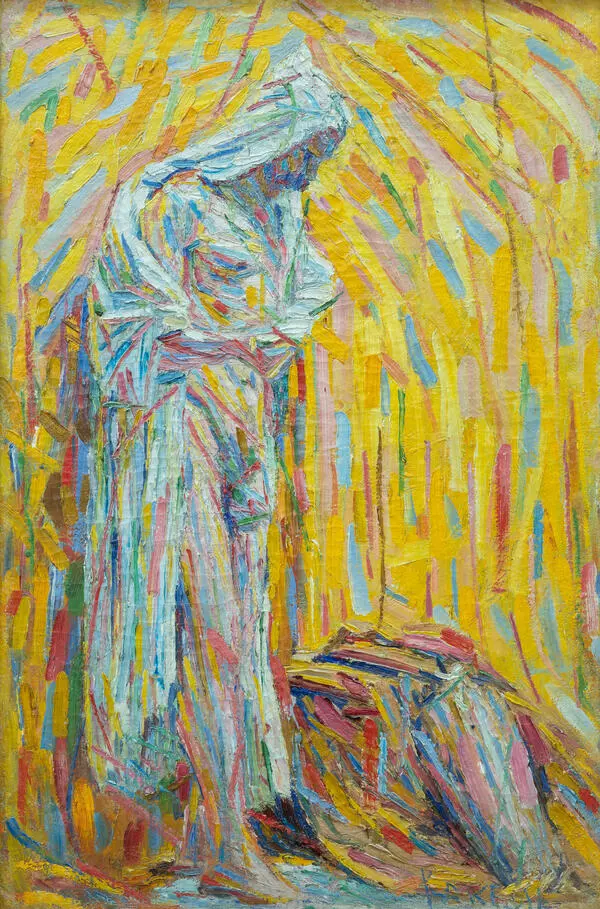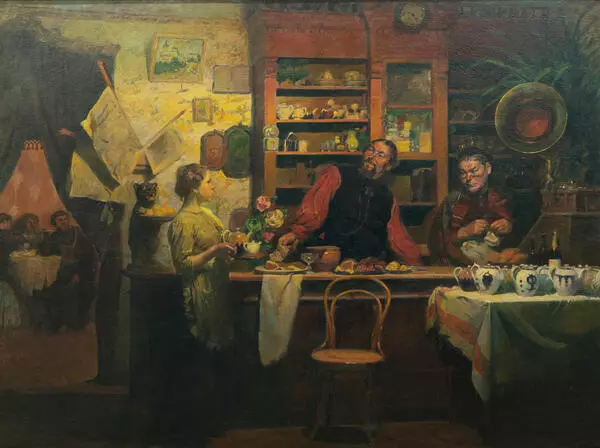After graduating from the Imperial Academy of Arts, Alexey Afanasyevich Kokel never returned to Chuvashia. In 1916, he moved to Kharkiv where he lived and worked for the rest of his life. During the Russian Civil War, he was appointed the chief military artist of Ukraine. His sketches were used to decorate Kharkiv during holidays, design agit-trains that went to the front line, decorate performances, and create posters. He became one of the founders and the first chairman of the Association of Artists of Red Ukraine. He was also the rector of the Kharkiv Art Institute. At the same time, he kept in touch with his homeland.
The painting “Likbez” was created for the exhibition dedicated to the 15th anniversary of the Chuvash Autonomous Oblast. Before the 1917 revolution, over 80% of people in Chuvashia were illiterate. The elimination of illiteracy, or “Likbez” for short, was undertaken by the Soviet authorities and became a relevant theme in the new style of socialist realism. In the 1920s, around 70,000 people received training with the help of the Likbez campaign in the new autonomous region of Chuvashia, or almost every eighth adult person. Most of the students were women. The educational process did not always go smoothly, especially in the beginning. The most critical issues were the lack of writing materials and spelling books and the reluctance of the students. However, despite all the difficulties, the Likbez campaign was effective: by the mid-1930s, the literacy rate in Chuvashia reached 90%.
The painting depicts adult students sitting together around a wooden classroom table. To the left, against the background of a blackboard, an elderly man sits in profile to the viewer, wearing a simple brown jacket. He diligently writes something on a piece of paper. Next to him, there is a woman wearing a white headscarf and a blue sweater. She watches the right hand of the teacher who is showing her something in a notebook. On the table, there are two inkwells, pencils, and some booklets. Four more women listen to the teacher, with their figures exuding calmness and diligence.
The teacher is a woman with short black hair, wearing a striped urban-style jacket. She is depicted standing in the center of the composition. The triangular composition is crowned by the portrait of Vladimir Lenin against a red wall. The artist made skillful use of a variety of shades of red, which gave the picture an overall warm color palette and made the atmosphere feel more formal.
The painting “Likbez” was created for the exhibition dedicated to the 15th anniversary of the Chuvash Autonomous Oblast. Before the 1917 revolution, over 80% of people in Chuvashia were illiterate. The elimination of illiteracy, or “Likbez” for short, was undertaken by the Soviet authorities and became a relevant theme in the new style of socialist realism. In the 1920s, around 70,000 people received training with the help of the Likbez campaign in the new autonomous region of Chuvashia, or almost every eighth adult person. Most of the students were women. The educational process did not always go smoothly, especially in the beginning. The most critical issues were the lack of writing materials and spelling books and the reluctance of the students. However, despite all the difficulties, the Likbez campaign was effective: by the mid-1930s, the literacy rate in Chuvashia reached 90%.
The painting depicts adult students sitting together around a wooden classroom table. To the left, against the background of a blackboard, an elderly man sits in profile to the viewer, wearing a simple brown jacket. He diligently writes something on a piece of paper. Next to him, there is a woman wearing a white headscarf and a blue sweater. She watches the right hand of the teacher who is showing her something in a notebook. On the table, there are two inkwells, pencils, and some booklets. Four more women listen to the teacher, with their figures exuding calmness and diligence.
The teacher is a woman with short black hair, wearing a striped urban-style jacket. She is depicted standing in the center of the composition. The triangular composition is crowned by the portrait of Vladimir Lenin against a red wall. The artist made skillful use of a variety of shades of red, which gave the picture an overall warm color palette and made the atmosphere feel more formal.





